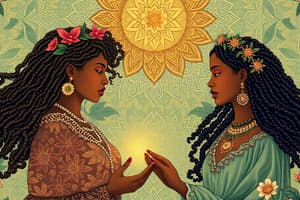Podcast
Questions and Answers
What is the main idea of intersectionality?
What is the main idea of intersectionality?
- Studying the effects of a single social category on an individual
- Focusing on the experiences of a specific group or community
- Analyzing the relationships between individuals and their social environments
- Examining how multiple social categories intersect and interact to produce unique experiences (correct)
Intersectionality only focuses on individual experiences of discrimination.
Intersectionality only focuses on individual experiences of discrimination.
False (B)
What is meant by 'interlocking systems of oppression'?
What is meant by 'interlocking systems of oppression'?
The idea that systems of oppression (e.g., racism, sexism, homophobia) are interconnected and cannot be understood in isolation from one another.
The phenomenon where individuals or groups are overlooked or excluded because they do not fit into a single category is known as ____________________.
The phenomenon where individuals or groups are overlooked or excluded because they do not fit into a single category is known as ____________________.
Which of the following is a principle of intersectionality?
Which of the following is a principle of intersectionality?
Intersectionality is only relevant in academic contexts.
Intersectionality is only relevant in academic contexts.
Match the following concepts with their definitions:
Match the following concepts with their definitions:
What is the risk of overlooking or erasing the experiences of certain groups, particularly those with multiple marginalized identities?
What is the risk of overlooking or erasing the experiences of certain groups, particularly those with multiple marginalized identities?
Flashcards
Intersectionality
Intersectionality
A framework that examines how multiple social categories intersect, creating unique experiences of discrimination and privilege.
Interlocking systems of oppression
Interlocking systems of oppression
The interconnected nature of oppressive systems like racism, sexism, and homophobia; these systems cannot be understood in isolation.
Multiple marginalities
Multiple marginalities
The marginalization or exclusion someone experiences, based on multiple aspects of their identity.
Intersectional invisibility
Intersectional invisibility
Signup and view all the flashcards
Centering marginalized voices
Centering marginalized voices
Signup and view all the flashcards
Interrogating power dynamics
Interrogating power dynamics
Signup and view all the flashcards
Contextualizing experiences
Contextualizing experiences
Signup and view all the flashcards
Erasure and invisibility (challenges)
Erasure and invisibility (challenges)
Signup and view all the flashcards
Study Notes
Intersectionality
Definition
- Intersectionality is a framework that examines how multiple social categories (e.g., race, gender, class, sexuality, religion, ability) intersect and interact to produce unique experiences of discrimination and privilege.
Key Concepts
- Interlocking systems of oppression: The idea that systems of oppression (e.g., racism, sexism, homophobia) are interconnected and cannot be understood in isolation from one another.
- Multiple marginalities: The experience of being marginalized or excluded based on multiple aspects of one's identity.
- Intersectional invisibility: The phenomenon where individuals or groups are overlooked or excluded because they do not fit into a single category (e.g., women of color, LGBTQ+ people of color).
Principles
- Centering marginalized voices: Prioritizing the experiences and perspectives of those who are most marginalized and excluded.
- Interrogating power dynamics: Examining how power operates at the intersections of different social categories to produce and maintain systems of oppression.
- Contextualizing experiences: Recognizing that individual experiences are shaped by their specific context, including their social location and historical moment.
Intersectionality in Practice
- Analyzing intersections: Identifying how multiple social categories intersect to produce specific outcomes or experiences.
- Developing inclusive policies: Creating policies that take into account the unique needs and experiences of diverse groups.
- Fostering intersectional solidarity: Building alliances and coalitions across different social categories to challenge systems of oppression.
Challenges and Limitations
- Erasure and invisibility: The risk of overlooking or erasing the experiences of certain groups, particularly those with multiple marginalized identities.
- Simplification and reduction: Reducing complex intersectional issues to single-axis analyses or oversimplifying the experiences of marginalized groups.
- Power dynamics within social justice movements: Recognizing and addressing power imbalances within social justice movements that may prioritize certain voices or experiences over others.
Intersectionality
Definition
- Examines how multiple social categories (e.g., race, gender, class, sexuality, religion, ability) intersect and interact to produce unique experiences of discrimination and privilege.
Key Concepts
- Interlocking systems of oppression: Racism, sexism, homophobia, and other systems of oppression are interconnected and cannot be understood in isolation.
- Multiple marginalities: Experiencing marginalization or exclusion based on multiple aspects of one's identity.
- Intersectional invisibility: Overlooking or excluding individuals or groups because they do not fit into a single category (e.g., women of color, LGBTQ+ people of color).
Principles
- Centering marginalized voices: Prioritizing the experiences and perspectives of those who are most marginalized and excluded.
- Interrogating power dynamics: Examining how power operates at the intersections of different social categories to produce and maintain systems of oppression.
- Contextualizing experiences: Recognizing that individual experiences are shaped by their specific context, including their social location and historical moment.
Intersectionality in Practice
- Analyzing intersections: Identifying how multiple social categories intersect to produce specific outcomes or experiences.
- Developing inclusive policies: Creating policies that take into account the unique needs and experiences of diverse groups.
- Fostering intersectional solidarity: Building alliances and coalitions across different social categories to challenge systems of oppression.
Challenges and Limitations
- Erasure and invisibility: Overlooking or erasing the experiences of certain groups, particularly those with multiple marginalized identities.
- Simplification and reduction: Reducing complex intersectional issues to single-axis analyses or oversimplifying the experiences of marginalized groups.
- Power dynamics within social justice movements: Recognizing and addressing power imbalances within social justice movements that may prioritize certain voices or experiences over others.
Studying That Suits You
Use AI to generate personalized quizzes and flashcards to suit your learning preferences.



